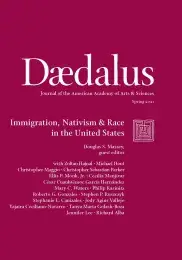Status Threat: Moving the Right Further to the Right?
Over the last few years, right-wing movements have proliferated among Western democracies. Although much of the growth has taken place across the “pond” in Europe, this phenomenon is not confined to that continent. As recent events make clear, the United States is another major case. In this essay, I offer a theory of the emergence of reactionary movements, fueled by status threat, using the United States as a case. To demonstrate the explanatory range of the theory (and measure), I focus on immigration, impeachment, and support for Donald Trump in the 2020 election. Examining self-identified Republicans only, I argue that status threat motivates the reactionary wing of the GOP in the United States. Drawing on data culled from a national sample, I find support for my expectation that, beyond ideology and racism, status threat furnishes a new explanation for reactionary preferences. I close with a discussion of the implications.
The rise of right-wing movements in Western democracies over the last several years is difficult to ignore. From Australia to Europe, right-wing movements have achieved a measure of political success.1 The reactionary right has increased its vote share in Austria, Finland, France, the United Kingdom, Greece, Norway, Portugal, and Sweden.2 Further, in at least thirteen European countries, these reactionary parties have taken part in governing coalitions.3 But Europe is not the only locale in which the reactionary right’s political presence is a factor. A more complete accounting of the political influence of the reactionary right in the last twenty years must also include the United States.
America’s most recent move to the right began with the Tea Party’s emergence during the Obama administration. After storming the American political scene in 2009, the “leaderless” movement was largely responsible for the GOP takeover of the House of Representatives in the 2010 election cycle.4 The Tea Party sought to maintain the cultural integrity of what it viewed as the “legitimate” American majority.5 While Donald Trump sometimes departed from Republican free-market orthodoxy, his use of Anglo cultural appeals is very similar to, and often even more overt than, the Tea Party’s use of them.6 Repeatedly referencing bygone periods when America would “win,” Trump made restrictions on both legal and illegal immigration central to his appeal, promising to protect the “forgotten people” from the depredations of gangs and terrorists supposedly flooding the country’s borders.
For anyone with even a passing familiarity with the American political right, the Trump administration’s positions are hardly commensurate with conservatism.7 A more fitting descriptor is reactionary. At best, reactionaries, driven by status threat, seek to preserve existing social and economic arrangements; at their worst, they desire a return to the less egalitarian arrangements of the past, a style of politics typically associated with right-wing political movements.8 Cleavages on the right between groups motivated by status threat and more establishment-style conservatives are traceable to at least the early 1960s, when conservatives began to part ways with the wing of the party preoccupied with maintaining White social prestige. It began with the rise of the John Birch Society (JBS) in the late 1950s, a reactionary group run by retired candy manufacturer turned conservative activist Robert Welch. Eventually, the father of postwar conservatism, William Buckley Jr., would eject Welch and the JBS from the conservative movement properly understood, but not before the latter turned its membership and money toward the nomination of Senator Barry Goldwater in 1964.9 More recently, through its obsession with the Obama presidency, the Tea Party adhered to the status threat model, breaking away from the more establishment conservatism of the George W. Bush presidency.10
Conservatives, on the other hand, are not generally animated primarily by change-induced threat. Instead, they are willing to accept change so long as it means retaining social, economic, and political stability. Relative to those motivated by eliminating threats to status, conservatives typically reject racial profiling and suppressions of free speech, especially if such actions might result in violence. One way in which to view the observed differences between conservatives and people moved by status threat is that the former are more pragmatic, whereas the latter are more dogmatic. While conservatives prize order and stability above all else, people operating under status threat are more concerned with maintaining group prestige in a changing society.11
What explains the surge in reactionary politics in the United States? Many so-called experts have long claimed that economic threat is the source of reactionary politics. The logic connecting the emergence of right-wing movements and economic anxiety is rooted in concerns over economic competition from non-Whites during economic downturns.12 The theory is that working-class Whites gravitate toward reactionary movements because those movements claim they will preserve or recover working-class jobs. Arguments emphasizing economic threat are often used to explain membership growth of the Ku Klux Klan (KKK) in the 1920s, the Tea Party, Scott Walker’s support in Wisconsin, and, of course, Donald Trump.13 This explanation is plausible for those who are objectively working class, but it fails to tell us anything useful about those who do quite well economically, but remain attracted to reactionary movements.14
Other accounts of reactionary movements place difference of some kind at the center, but it is most frequently associated with racism.15 Connecting racism to right-wing movements does not require much imagination and, as mentioned above, this relationship is well documented. Even so, racism may not be the sole source of intolerance when it comes to reactionary politics. Building on historian Richard Hofstadter who, in turn, built on sociologist Joseph Gusfield’s seminal work on the Temperance Movement, political scientist Matt Barreto and I argued that the Tea Party was motivated by perceived threats to its members’ way of life.16 Indeed, more recent work makes the same case. For instance, political scientist Diana Mutz has shown that more generalized intolerance–status threat–influenced support for Trump in 2016 even after accounting for race-specific intolerance.17
In this essay, I illustrate the ways in which status threat informs preferences on the right. In the American context, this suggests a focused analysis of the Republican Party. In theory, in the presence of partisan polarization and partisan sorting, it should prove difficult to find daylight of any kind in the mass public among GOP partisans.18 To make matters even more challenging, I examine immigration, Trump’s impeachment, and political choice in the 2020 election, areas on which one should find unanimity on the right. Yet even in these domains, cleavages on the right exist. This may seem a surprise to some, but the results merely corroborate recent work on the GOP that reveals a rift on the right, the latest installment of a long-running saga, at least fifty-five years in the making.19
This essay opens with a discussion of reactionary movements in the United States. The American reactionary right is motivated, in the main, by what its adherents perceive as rapid social change, change that challenges the foundations of American identity: White patriarchal dominance. (Such microlevel motives related to identities typically connect individuals to movements.)20 Drawing on prior work, I then assess the predictive validity of the proposed model of reactionary politics. I show that status threat goes a long way toward explaining everything from political choice (supporting Trump) to issues on immigration, all while accounting for the “usual suspects” such as social dominance, racism, and authoritarianism. I close with a few words on the meaning of these findings in light of two alternative explanations for the rise of the reactionary right: “populism” and nationalism.
In our book Change They Can’t Believe In: The Tea Party and Reactionary Politics in Contemporary America, Matt Barreto and I argue that reactionary movements are motivated by anxiety associated with the perception that social change is happening too fast.21 For example, in addition to the election of Barack Obama as the first non-White man to the White House (an enormous change in its own right), the increasing visibility of gay rights, women’s rights, and immigrant rights contributed in no small way to spurring–and sustaining–the Tea Party movement. In other words, these were social and cultural course corrections, changes away from a norm in which American identity coincides with White Anglo-Saxon Protestantism.22 Indeed, demographically, Tea Party sympathizers tended to be older, White, male, Christian, native-born, and middle-class; a demographic group very similar to the aforementioned “prototypical” American.23
This is not the first time that demographic change spearheaded a reactionary movement in the United States. During the mid-nineteenth century, the Know Nothings, also known as the American Party, were concerned, among other things, with the growing presence of immigrants. They believed that immigrants’ attachment to Catholicism was a political and moral threat, and perceived them as susceptible to criminality, posing a security threat to the country.24 In the early twentieth century, the resurgent Ku Klux Klan and its supporters perceived a threat from Blacks, Jews, Catholics, labor unions, and the increasing independence of women.25 Similarly, members and supporters of the JBS in the 1950s and 1960s believed the “American way” of life to be under siege, arguing that the expansion of the federal government threatened to subvert their freedom and transform the United States into a totalitarian regime.26
From the Know Nothing Party to Trump’s GOP, these reactionary movements have much in common. For starters, in each case, the movements were a reaction to what its constituents perceived as a threat to the “American” way of life. Unlike establishment conservatives who see social change as something that must be tolerated, if not necessarily embraced, in exchange for order and stability, reactionaries consider social change subversive.27 Further, in all four examples, the demographic group that feels most threatened is commensurate with that segment of society closest to the stereotype on which American national identity rests.28
My theory of reactionary politics, the foundation of which is status threat, is key to explaining the Trump revolution.29 I have already outlined the ideal political community for American reactionaries. For them, this restrictive definition of “legitimate” American identity carries significant meaning. Theorists of symbolic politics argue that symbols link individual (and group) objectives and aspirations to the wider social and political world.30 In my formulation of reactionary politics, the political community, among the more powerful political symbols, serves as the object of the affection for reactionaries–people motivated by status threat.31 Further, political community as symbol often 1) inspires intense affection and 2) pushes people to protect and preserve its meaning at all costs.32 Consequently, threats to “real Americans” (the political community for reactionaries) and their way of life inform their political preferences.
More than anything, the dominant group’s belief that its values and way of life constitute the highest expression of human achievement serves as a source of motivation when society is changing too fast. Moreover, as a means of explaining what they perceive as suddenly changing circumstances, they contend that an organized conspiracy of some kind is responsible. To use language commensurate with the task of connecting these observations with established theoretical concepts, status threat consists of three subdimensions: existential threat, ethnocentrism, and paranoid social cognition. We begin with existential threat.
American reactionaries, as I have suggested, believe their way of life is under threat.33 Further, as I have already made clear, the Know Nothings, the Klan of the 1920s, and the Tea Party believed “real” America was in danger. In general, this is typically associated with a perceived shift in the status quo in which culturally dominant groups feel that their way of life is threatened by the rising influence of culturally subordinate groups.34 However, this reasoning also extends to relationships between racial dominants and subordinates.35 Among high-status groups, and especially among high identifiers within the groups, the preferred remedy to perceived threats is the imposition (or perpetuation) of social inequality.36 This is something frequently observed with reactionary movements.37
Another component I believe associated with reactionary politics is the paranoia to which Hofstadter referred. Of course, this is not about clinical paranoia, but a paranoia of a more political nature. In this case, anxiety gives rise to what social psychologist Roderick Kramer once referred to as “paranoid social cognition,” a condition in which people have a difficult time adjusting to rapidly changing circumstances.38 To make sense of changing circumstances in which one’s status is in flux, members of the in-group–if they are to maintain a sense of collective esteem–must identify an out-group responsible for the in-group’s perceived decline. Part of this process includes generating stereotypes of the dominant out-group, including conspiracies.39 Members of the in-group become increasingly anxious and, therefore, paranoid about the perceived decline of their position in society. Similar processes motivated the conspiratorial claims concocted by Know Nothings, the Klan, the JBS, and the Tea Party, and suggests why I include this trait as a component of status threat.40
The final ingredient is ethnocentrism. I stress ethnocentrism for two reasons. First, to the extent that ethnocentrism places the in-group at the center, one need look no further than the regularity with which American reactionaries have, over the years, referenced “the American way of life” and “real Americans.”41 Further, to make this global in scope, the group-based component of the reactionary right must include racism and nativism: racism to capture the centuries-old Black-White conflict, nativism for more recent arrivals.42 Ethnocentrism fits the bill. According to sociologist William Sumner, ethnocentrism is about the superiority of the in-group, which results in out-group derogation. Unpacking this simple dichotomy suggests that ethnocentrism is actually more complex.43 Among other factors, preference for one’s group, belief in the in-group’s cultural superiority and purity, and the welfare of the in-group taking precedence over the welfare of other groups is capacious enough to accommodate the intergroup dynamics identified by racism and nativism. Further, it does so parsimoniously and is not limited by time.44 In other words, ethnocentrism in the twenty-first century is very much like ethnocentrism at the beginning of the twentieth century.
I contend that existential threat, paranoid social cognition, and ethnocentrism, collectively, index status threat.45 Of course, each subdimension, by itself, represents a distinct theoretical approach. However, as other scholars of intolerance have demonstrated, social science sometimes requires a more synthetic theoretical approach. For example, social dominance theory, right-wing authoritarianism, and racial resentment all weave at least two theories together into a single approach.46
Using a six-item scale in which two items tap each of the three dimensions, my colleagues and I tested this formulation, and the model fit the data.47 Further, the model of status threat performed well in tests of convergent and discriminant validity. For instance, status threat enjoys a strong relationship with racial resentment, but is also shunned by those who place themselves on the “liberal” end of the ideological spectrum. On assessing the predictive validity of status threat, I investigated how it might fare predicting support for the Tea Party. This is key in that Barreto and I employed support for the Tea Party as a proxy for status threat.48 To make things interesting, we controlled for partisanship, ideology, and racial resentment, all of which are closely related to support for the Tea Party. As it turns out, even after accounting for other related factors, status threat was bested–albeit narrowly–only by racial resentment in predicting support for the Tea Party.
Armed with this direct measure of status politics (status threat), I now turn to the task of assessing the extent to which it informs how residents of the political right–that is, Republican partisans–view immigration, Trump’s conduct and potential consequences, and support for the incumbent president in the 2020 election. Immigration is a subject of inquiry for at least three reasons: 1) concerns about undocumented Latino immigrants are a principal reason why Whites switch to the Republican Party; 2) in 2016, concerns about immigration tended to push people to support Trump; and 3) prior to the coronavirus sweeping the nation, a Gallup poll showed that only terrorism/national security bested immigration as the most important issue among GOP partisans.49 Trump’s (first) impeachment represented another issue of interest given the robust support among rank-and-file Republicans (86 percent) who thought he should retain his office.50 With an overall approval rating of 91 percent among Republicans, Trump was buoyed at the polls in 2020 by a party that closed ranks around their president, even after his mishandling of the coronavirus and ordering troops to invade American cities.51
Again, the central question is whether status threat is a source of division among Republicans. But what of alternative explanations? How is authoritarianism relevant to contemporary politics?52 We would expect authoritarians, as people who prefer conformity above all else, to reject immigrants (and immigration) at all costs and support all things Trump.53 Similarly, social dominance orientation, a belief system organized around the perceived existence of dominant and subordinate social groups, also informed support for Trump in 2016.54 Last but certainly not least, we must also account for racism.55 Race and racism are at the center of contemporary politics.56 If we are to have any confidence in the explanatory power of status threat, we must account for these alternative explanations.
Turning first to immigration, I used the following questions to gauge the public’s attitudes toward immigrants and immigration:
- Do you support or oppose an effort by the federal government to deport all undocumented immigrants and send them back to their home countries?
- Do you think it should be easier or harder for foreigners to immigrate to the United States legally than it is currently?
- Do you support or oppose providing a legal way for “illegal” immigrants already in the United States to become American citizens?
I combined these items into an index as a means of exploring attitudes toward immigration.57
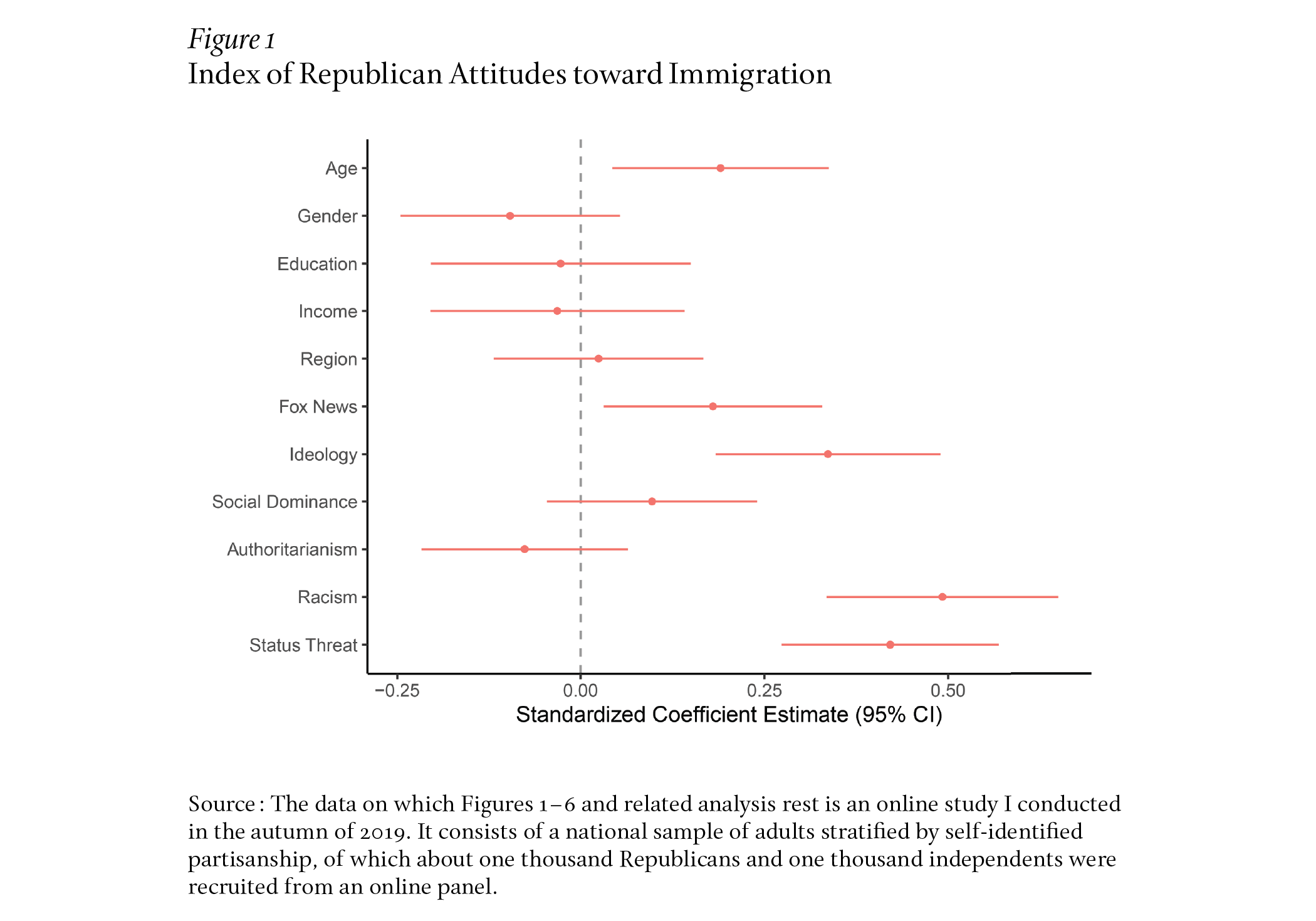
As the results suggest, there is less consensus on immigration in the GOP than one might think.58 It seems as if the most status-threatened Republicans take a harder line on immigration than co-partisans who are more secure in their position in America. In fact, status threat is only bested by racism in its influence on immigration attitudes on the political right. No real surprise here, though, given the ways in which immigration is often racialized.59 Hardcore, self-identified conservatives are, likewise, less than forgiving when it comes to immigration policy. Clearly, a steady diet of Fox News tends to push people away from toleration of immigration. The only demographic explanation that provides any leverage is age, with younger Republicans reporting more tolerant attitudes toward immigration relative to their older counterparts.
We turn our attention next to President Trump’s conduct: allegedly soliciting foreign involvement in the American political process when he requested that Ukraine investigate his political rival, Joe Biden. Though he was ultimately impeached, the Republican conference in the Senate held fast (Mitt Romney as the lone exception), and Trump was not removed from office. To tap into Republican sentiment around this incident, I asked three questions:
- Do you think it was appropriate or inappropriate for the president to request a foreign government open an investigation into one of his potential political opponents?
- Some people think President Trump should be impeached and removed; others think he shouldn’t be impeached and removed. What do you think?
- Some people think President Trump abused the power of his office by urging the President of Ukraine to open an investigation of a potential opponent in the next election. Other people think that the House is just playing politics and oppose the impeachment inquiry. What about you? What do you think?60
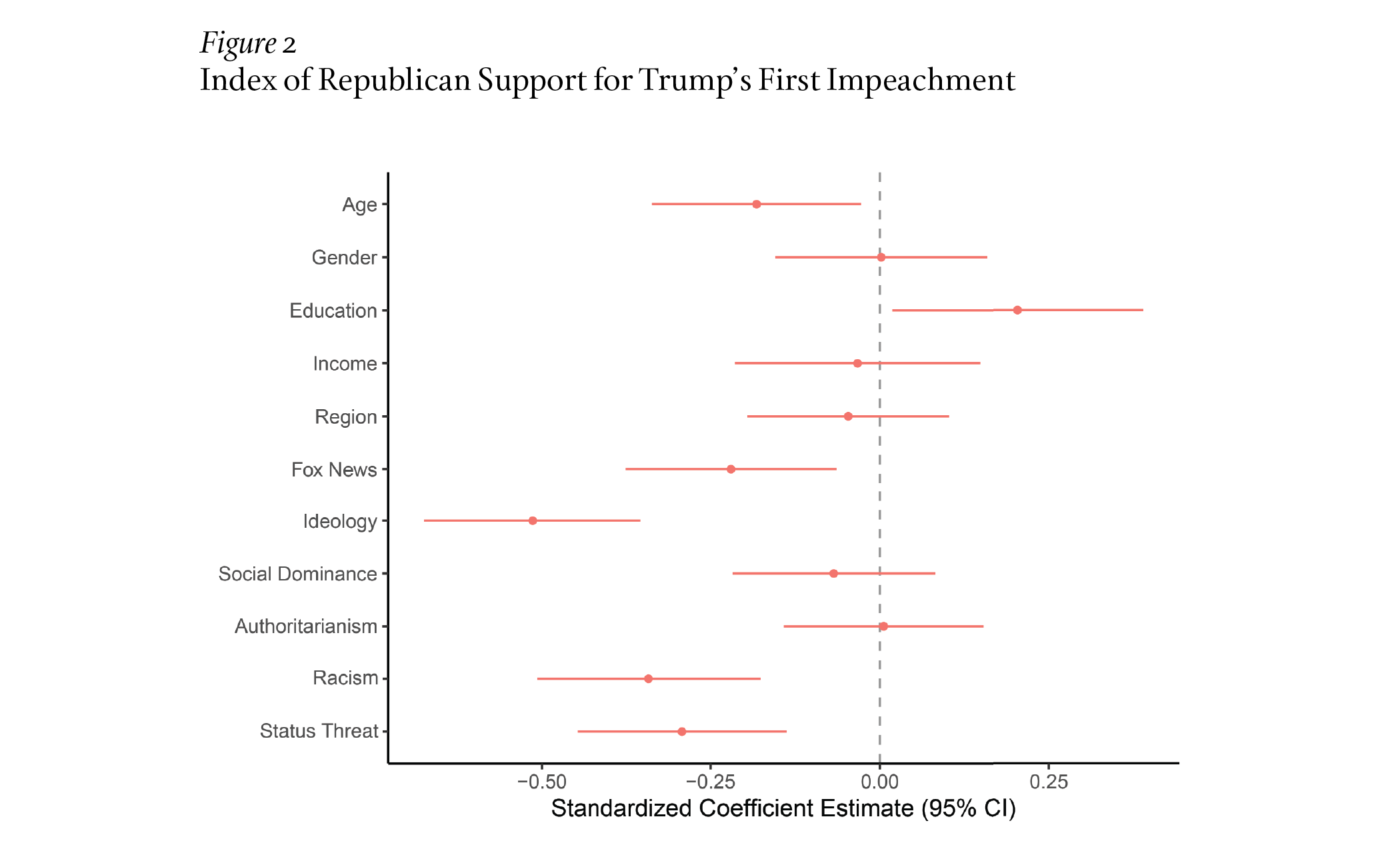
The results for impeachment mirror those for immigration insofar as they reveal cracks among the Republican faithful. For instance, more educated Republicans and less conservative Republicans (the ideology trait) are more likely to have favored impeachment than less educated and more conservative GOP partisans, respectively. On the other hand, consumption of Fox News appears to have dampened the appetite for impeachment, encouraging disbelief or a more forgiving disposition toward Trump’s alleged abuse of power. Again, status threat weighs in on the preferences for Republicans: the more status threatened Republicans are, the more forgiving they are toward Trump’s alleged transgressions, and the less they support impeachment and possible removal from office.
Finally, I address what motivated Republicans to support Trump or not in the 2020 election cycle. To gauge support for Trump in 2020, I asked: “How likely are you to vote to reelect President Trump in 2020?” As we observed with immigration and impeachment, there are considerable differences among co-partisans. For starters, the likelihood of voting for Trump varies with age, with older partisans more inclined to support the incumbent than younger ones. Watching Fox News also predicted support for Trump in 2020. Ideology also plays a role here: increasing self-declared conservatism increased support for Trump during the election. Having said this, racism is the most powerful predictor in the model, but not by much. Again, status threat makes a strong showing, albeit narrowly beaten out by racism in shaping the likelihood that Republicans in the public will vote for Trump in the most recent election.
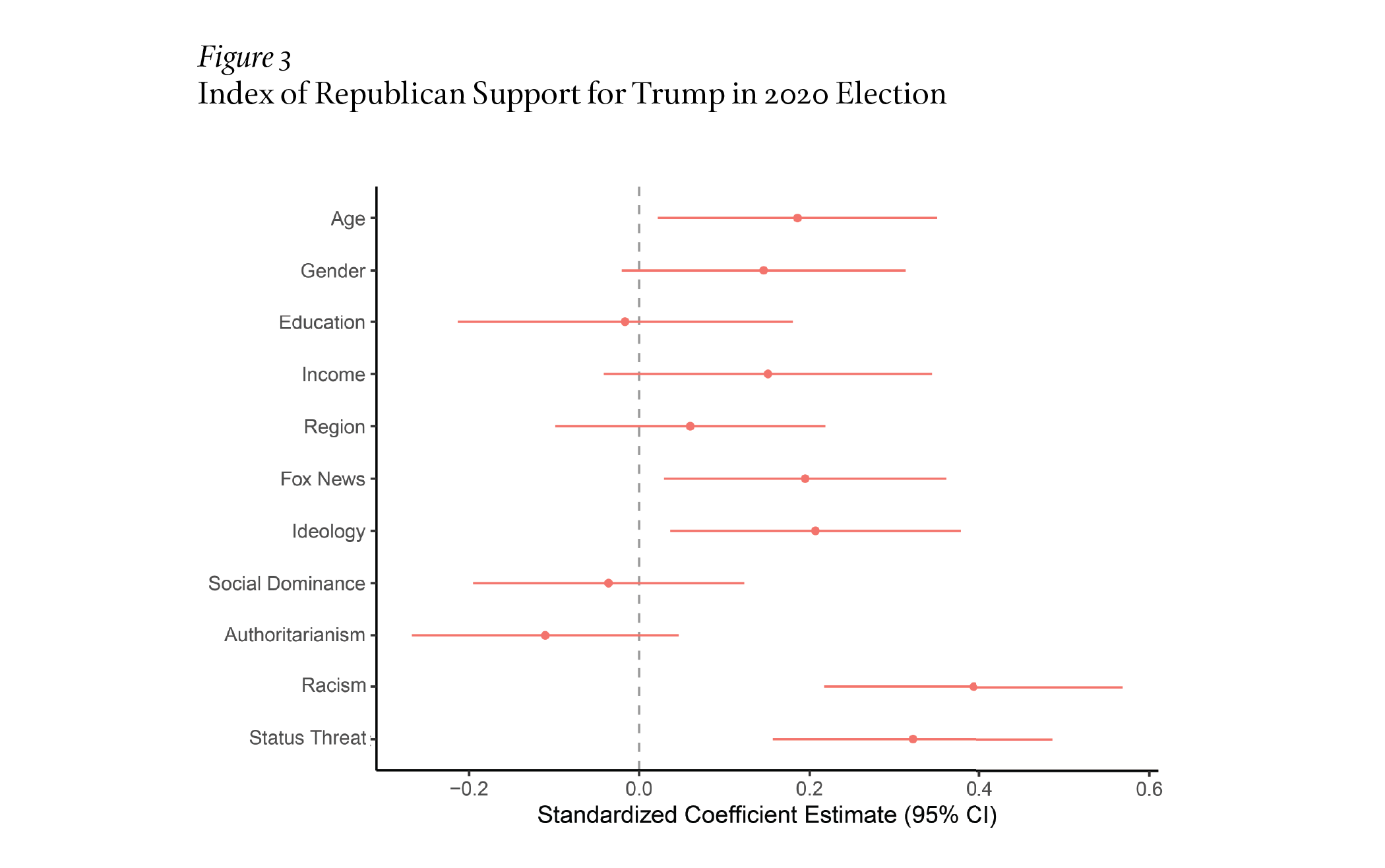
Even a cursory examination of the results makes clear the explanatory power of status threat. To be sure, other factors emerged as consistent predictors, especially consumption of Fox News, ideology, and racism. Of these, ideology, in the guise of conservatism, is generally believed the chief threat to reactionary sentiments indexed by status threat.61 As such, a focused comparison between ideology and status threat is more than appropriate. For theoretical purposes, I focus on the higher values, ones that compare the “conservative” end of the ideological self-placement item, and those who believe their status is more threatened than others. The results are depicted in Figures 4, 5, and 6. Relative to hardcore conservatives, those who feel the status of their group threatened are more committed in their support for Trump in 2020 and more resolute in their refusal to welcome “illegal immigrants” than Republicans who believe their status isn’t so threatened. Even so, the differences are slight. A glance at the differences in the point estimates drives this home. When it comes to impeachment, no daylight exists between the groups. More than anything, in tandem with the findings in Figures 1–3, it is clear that status threat and conservatism each contributes to the ways in which Republicans in the mass public think about these issues. More to the point, the “status threatened” are motivated by anxiety associated with impending social and cultural displacement, while conservatives are more concerned with maintaining the status quo.
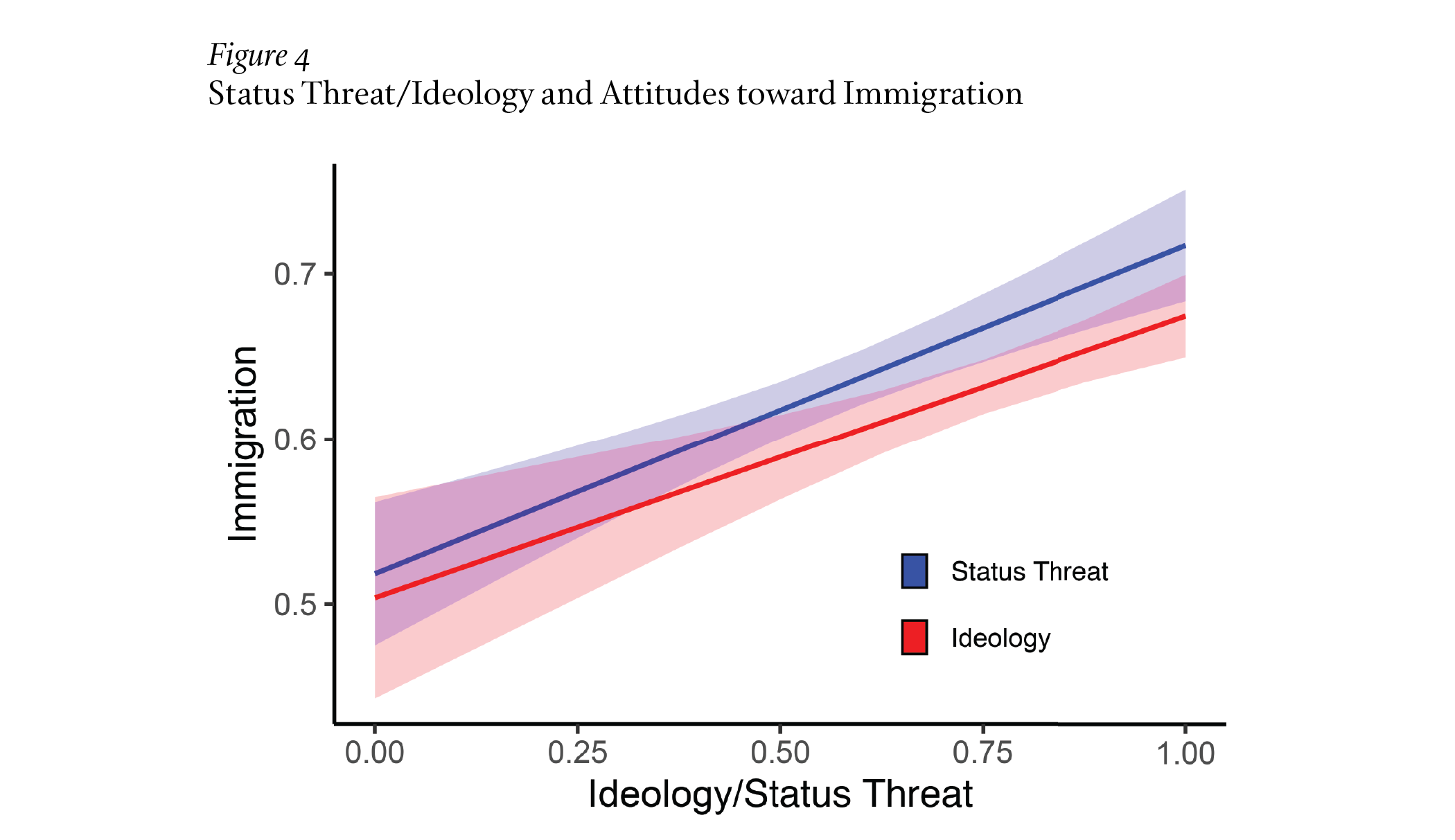
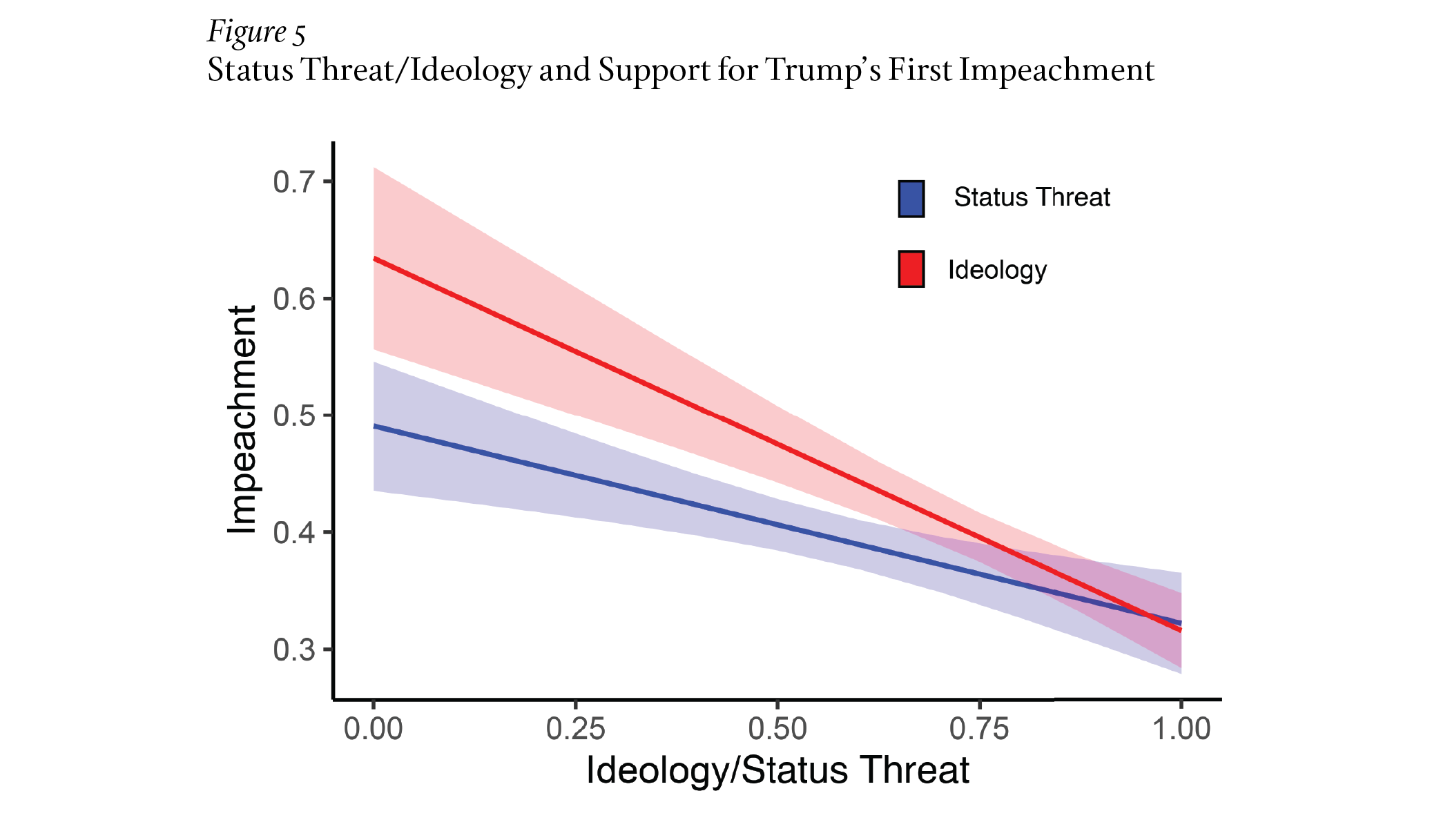
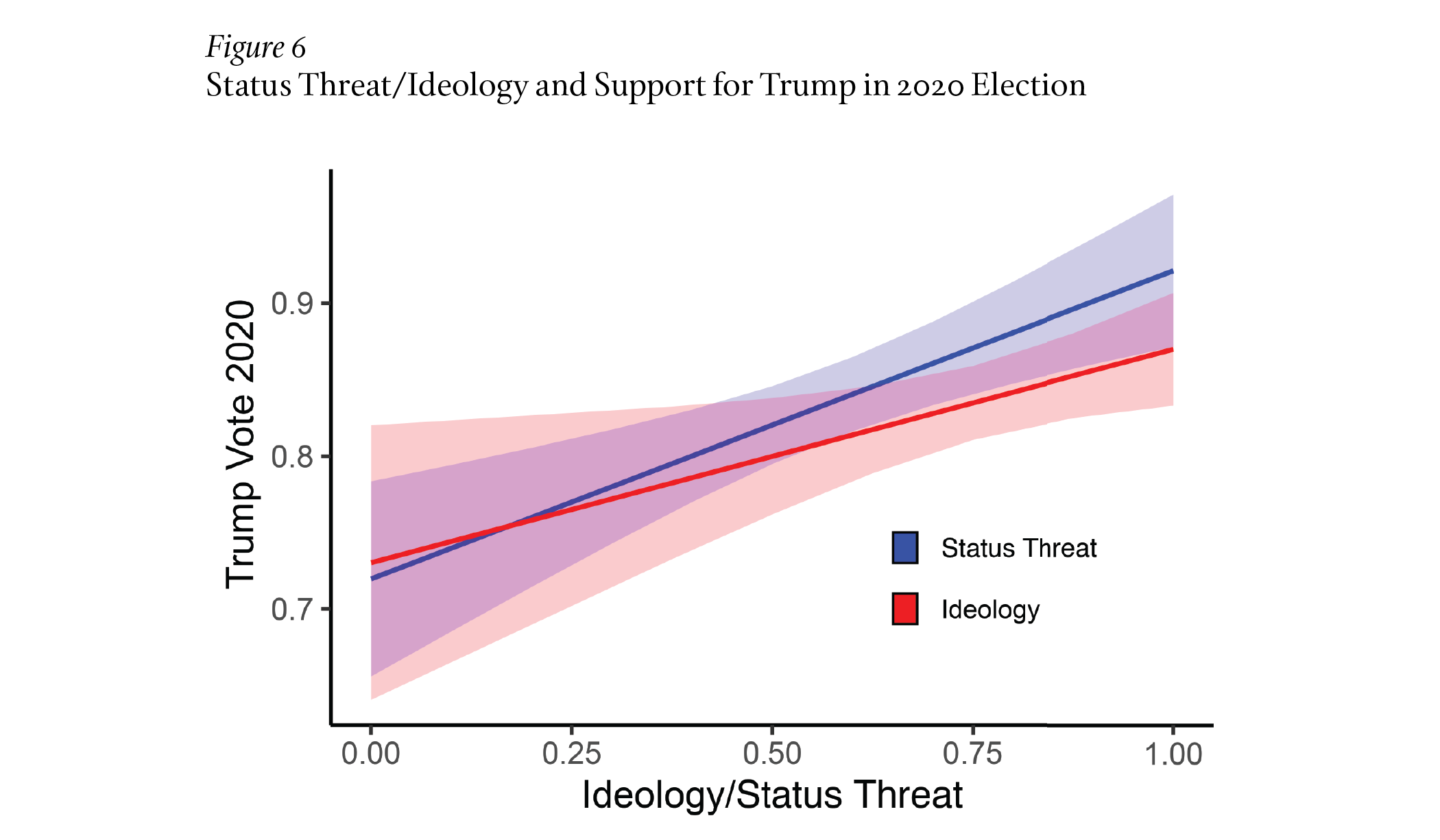
I was not caught by surprise by the inability of authoritarianism or social dominance orientation to gain traction. This has happened before.62 As it turns out, status threat explains the impact of both on reactionary sentiment, at least as they are related to Trump-based preferences. For instance, once I remove status threat from the model, the impact of both on Trump-related references becomes evident. Still, it may well be the case that alternative measurements of authoritarianism such as right-wing authoritarianism and a longer version of the social dominance orientation scale would fare better. For now, however, it seems as if next to racism, status threat is well positioned to explain contemporary Republican preferences, at least as they pertain to Trump.
Further, these findings connect well to recent work that identifies an insurgent wing of the GOP and that pinpoints status threat as a source of the rift.63 Finally, these results successfully interrogate the proposition that class has anything to do with reactionary politics.64 Whether assayed by education or income, class has mostly no impact on contemporary reactionary politics, something that confirms prior work.65 In sum, in a properly specified model in which symbolic threat is included, material threat fails to tell us much about reactionary politics.
Right-wing movements are enjoying a global resurgence. Nowhere is this more true than in the United States where, beginning with the Tea Party, the GOP permitted a reactionary movement to hijack a major party, with disastrous consequences. To some, the Trump presidency began to transform the United States into an authoritarian regime.66 If this happened, it wouldn’t be the first time in the United States. The role the Ku Klux Klan played in the solidification of Jim Crow and the threats carried out by the White Citizens Councils after Brown v. Board of Education represent other instances in which a reactionary movement, driven by status threat, challenged American democracy.67 Given the dispositive role of race in American history, it’s no surprise that racism looms large in reactionary movements and the ensuing politics.
Having said this, the discerning reader may wonder why I failed to include “populism” or nationalism as alternatives to status threat. This is a valid concern. On elaboration of the reasons for which I excluded them from the analysis, it will be clear why I’ve chosen to do so. I begin with populism.
Problems with the contemporary use of populism are manifold. I will discuss two here: the ontological and the empirical. Briefly, on the ontological front, some believe it a “thin” ideology; others, given the failure of populism to meet the criteria typically associated with ideologies, are given to calling it a rhetorical style deployed by elites.68 It stands to reason that ontological cloudiness on populism will lead to empirical issues, especially as they apply to microlevels of analysis, where some argue that populism is commensurate with an attitude.69 It is assumed that people who support populist platforms are themselves populists: that is, people motivated by economic issues and intolerance. Assessing the latter is fairly straightforward, and it does predict support for populist parties: antipathy toward immigrants tends to increase support for parties touting populist platforms.70 As it turns out, however, attempting to discriminate between populists and nonpopulists along class-based lines doesn’t always work. When indexed by subjective and objective class position, support for populism across studies is at best inconsistent. In fact, a recent paper suggests that, beyond intolerance, there is no one thing capable of defining the populist voter.71 Further, attempts to successfully measure populism at the mass level have proven difficult, including the American case.72
Nationalism, too, is a possible explanation for Trump’s success. He even thinks himself a nationalist. Nationalism, in a classical sense, according to historical sociologist Anthony Smith, is an “ideological movement for attaining and maintaining autonomy, [a] unified identity of a population deemed by some of its members to constitute an actual or potential ‘nation.’”73 Further, nationalism is generally thought a largely political project through which elites seek to justify rule over certain territory, to be inhabited by a mostly homogenous population.74 Elites make strategic decisions on whom to include in, and whom to exclude from, the nation-building project. This is done for the purpose of binding together more or less similar groups who may have been in conflict in the past, or might clash in the future. The creation of a newly constructed “we” against a “they” reinforces a sense of solidarity that will serve as the basis for the nation-state, while stigmatizing the “other.”
American nationalism, however, is a bit more complex. The same basic principles apply, like solidarity around a primordial identity. But the American variant includes at least one other component. American national identity, based as it is on liberal (enlightenment) principles, leans heavily on a set of values prescriptive of rights and duties that makes possible the concept of civic nationalism: belief in the American creed. Some, therefore, believe that American nationalism consists of racial and civic components.75 Political scientist Rogers Smith agrees with the racial and civic perspectives, but adds a third: republicanism.76 Other, data-driven perspectives include four dimensions of American nationalism.77 In other words, the contours of American nationalism remain murky.
That said, if the results from the analysis are any indication, status threat may well lend insight on what motivates reactionary politics. Unlike earlier reports claiming that class or economic anxiety carries the day, material motives, for the most part, offer next to nothing in the way of leverage when it comes to explaining reactionary politics and the right-wing movements they fuel. This suggests that scholars may wish to examine symbolic motives as a means of elaborating on reactionary movements. After all, the proposition that Trump’s victory was driven by working-class Whites is a myth: many of his followers are well-to-do, with two-thirds making more than the national median income.78 If reactionary politics in the United States is truly driven by the anxiety accompanying the dominant group’s belief that they’re losing “their” country, and not by economic concerns, no amount of redistribution will temper their support for draconian immigration measures, nor their willingness to countenance the move away from democracy.79 We need to look elsewhere, then, for the solution to the current predicament.
